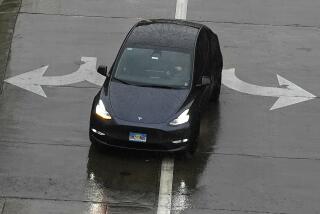New-Car Owner Thinks Dealer May Have Taken Things Too Far
- Share via
Question: I purchased a Volkswagen Passat with 95 miles on the odometer. It was sold to me as “new.” How many miles can a car have on it and still be considered new?
--J.M.H.
Answer: A vehicle can be described as “new” in California until it is sold and registered for the first time with the Department of Motor Vehicles.
DMV officials say there is no odometer reading in the definition of a new vehicle.
Section 430 of the California Vehicle Code defines a new vehicle as one constructed entirely from new parts that has never been the subject of a retail sale; registered with the department; or registered with the appropriate agency or authority of any other state or other political entity.
New cars and trucks typically have no more than a few dozen miles, accumulated after they drive off the factory assembly line.
New vehicles take on a few miles while driven in storage lots on their way to a dealership. Once there, they can be driven by prospective buyers on test drives, adding a few miles at a time.
In some cases, dealers also swap same-model vehicles to satisfy a customer who wants a specific color or equipment package. In such cases, the vehicles may be driven across town, which can be quite far in Southern California.
The 95 miles on your Passat is on the high side but certainly not high enough to raise suspicion that it was used extensively by dealership employees as a personal car.
But mileage is another issue in negotiating price. It is always important to inspect the specific car you are buying, including checking the mileage. Then you can at least try to negotiate a lower price based on the mileage.
Q: My 1998 Civic will soon reach 90,000 miles, which is the mileage at which Honda recommends changing the timing belt. However, the dealer’s service department says I should also replace the water pump because the new belt is tighter and will put more strain on the old pump. Is this true?
--F.L.D.
Q: It’s time to replace the timing belt on my 1994 Camry. Is it cheaper to replace other belts at the same time?
--F.C.
A: Replacing a water pump and other belts during a timing-belt repair can be a smart investment.
The recommendation is based not on that Honda dealer’s reasoning but on the expectation that the water pump will fail at some point and that changing it during a timing-belt replacement would add little additional cost.
Indeed, water pumps commonly fail after 90,000 miles. Such failures are unpredictable, can leave you stranded and in the worst case can cause extensive engine damage.
In many cases, the timing belt provides the power to the water pump. With the belt already off, changing the pump may require only a small fraction of an hour of labor. But if you have to change the pump later, you’ll pay for three or four hours of labor to remove the timing belt all over again.
Even on vehicles that have a separate serpentine belt to power the water pump, it’s often the case that the timing belt must be removed to get to the pump or the bolts that hold it.
It’s also smart to replace other belts when changing the timing belt, since you should be charged no additional labor.
Sam Memmolo, a recognized national expert on engine mechanics, says it also is wise with high-mileage cars to replace the idler and tension pulleys, since their bearings can wear out.
*
Ralph Vartabedian cannot answer mail personally but responds in this column to automotive questions of general interest. Please do not telephone. Write to Your Wheels, Business Section, Los Angeles Times, 202 W. 1st St., Los Angeles, CA 90012. E-mail: ralph .vartabedian@latimes.com.







